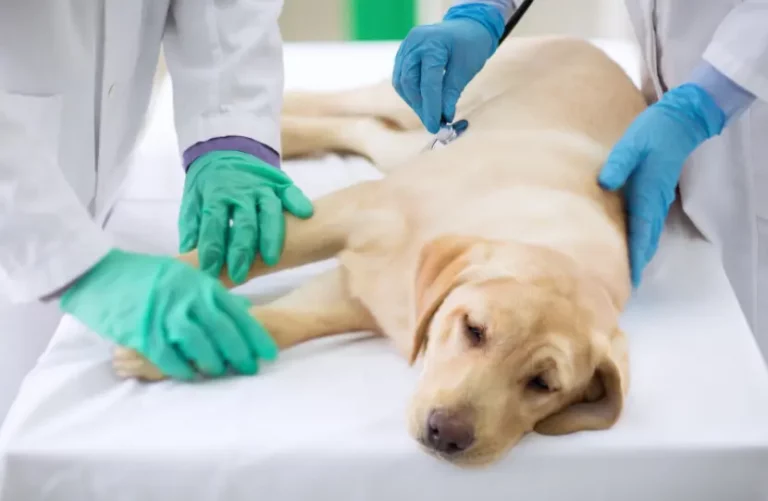Canine Epilepsy Symptoms, Stages, Diagnosis, And Treatment Process [Vet Advice]
Health conditions like canine epilepsy, are unavoidable. Nearly 5-7% of the estimated 89.7 million dogs in the United States suffer from epilepsy, experiencing recurrent seizures. Although the condition affects dogs of all breeds and sizes, some breeds, like Belgian Shepherds and Beagles, have a higher predisposition.
If your dog is one of the 5 million to 6 million with epilepsy, arming yourself with information is critical to properly managing their care. Seizures in dogs can appear as subtle as a short stare into space or more dramatic with “collapsing, paddling, and loss of bowel control.”
Most seizures last 1-3 minutes on average. Timing your dog’s seizures helps vets determine seizure type and optimal treatment. While frightening to witness, remember your dog is not in pain during a seizure, just confused. Stay calm, gently restrain them from injury, and track episode details like date, length, and appearance. This seizure log aids your vet in diagnosing epilepsy versus other conditions causing seizures like “metabolic disorders, organ diseases, toxins, and tumors.”
If your vet confirms epilepsy, they may prescribe anti-epileptic drugs like phenobarbital or potassium bromide to reduce seizure frequency and length. Though medication is key, good nutrition, exercise, decreasing stimuli, and supplements may also help control seizures.
![Canine Epilepsy Symptoms, Stages, Diagnosis, And Treatment Process [Vet Advice] 1 Canine Epilepsy Stages](https://www.puppiesdiary.com/wp-content/uploads/2023/11/Canine-Epilepsy-Stages.jpg)
Table of Contents
- What is canine epilepsy?
- The differences between primary and secondary canine epilepsy
- Common signs and symptoms of seizure
- Different stages of a seizure in dogs, including the prodrome phase
- Overview of etiology (causes) of canine epilepsy
- Potential triggers that can cause seizures in dogs
- Seizures caused by genetic and unknown factors
- Underlying structural problems or metabolic dysfunction
- Potential causes of seizures in dogs
- What are the key steps to take if your dog has a seizure?
- Canine seizure disorder categories based on the frequency
- Key signs that warrant immediate veterinary attention for a dog experiencing seizures
- Diagnosing and treatment of canine epilepsy
- Common terminology
- Accurate diagnosis and proper treatment
- Conclusion
- FAQ
What is canine epilepsy?
[The definition of canine epilepsy],
Canine epilepsy is a chronic neurological disorder characterized by recurrent seizures. It is the most common neurological condition affecting dogs. A seizure is a temporary abnormal electrical activity in the brain that results in “involuntary movement, behavior, sensation, or loss of consciousness.” Many medical conditions can cause seizures.
Epilepsy, on the other hand, is a disease process where dogs have repeated, unprovoked seizures over some time, usually more than 1 per month. Epilepsy indicates an underlying tendency for recurring seizures, while a one-time seizure event may not recur.
It’s important to note that not all dogs that experience a seizure have epilepsy. A single seizure does not automatically mean a dog is epileptic. Doctors diagnose epilepsy only when they cannot identify the cause of multiple recurrent seizure episodes.
Veterinary assessment over time is required to differentiate between isolated seizure events and true epilepsy. Accurate diagnosis allows proper long-term treatment and management of the chronic neurological disorder of canine epilepsy.
The differences between primary and secondary canine epilepsy
Canine epilepsy is categorized as either primary or secondary based on the underlying cause.
- Primary epilepsy, also called idiopathic epilepsy, has no identifiable structural cause in the brain. The seizures result from presumed hereditary factors or spontaneous genetic mutations affecting neurotransmitters, ion channels, or synaptic signaling. This type accounts for approximately 60%-70% of diagnosed canine epilepsy cases.
- Secondary epilepsy is due to an identifiable brain pathology or disorder such as:
- Structural causes like “head trauma, stroke, brain tumors, inflammation, or infection”
- Metabolic causes like “kidney or liver failure, electrolyte imbalances, or toxins”
- Reactive causes like severe stress or fever
The distinction between primary and secondary epilepsy is important because the treatment and prognosis differ between the two types.
Primary epilepsy will require lifelong anti-seizure medication and management as there is no curable underlying cause. Successfully treating the original disease or injury may resolve secondary epilepsy. Accurate classification by veterinary neurologists through diagnostic testing allows them to tailor therapy appropriately to either type of canine epilepsy.
Common signs and symptoms of seizure
Common symptoms to look for before, during, and after a dog experiences a seizure
![Canine Epilepsy Symptoms, Stages, Diagnosis, And Treatment Process [Vet Advice] 2 signs and symptoms of seizure](https://www.puppiesdiary.com/wp-content/uploads/2023/11/signs-and-symptoms-of-seizure.jpg)
- Before a seizure: abnormal barking, restlessness, clinginess, hiding, or appearing dazed may indicate your dog is experiencing an “aura” – a sense that a seizure is coming.
- During a seizure:
- Loss of consciousness
- Rigid muscles or jerking/twitching motions
- Drooling or foaming at the mouth
- Chewing motions or chomping
- Loss of bowel/bladder control
- Paddling of the legs
- After a seizure:
- Confusion, disorientation
- Unsteadiness, stumbling, weakness
- Temporary blindness or deafness
- Excessive hunger, thirst, or urination
- Vomiting
- Extreme fatigue
Witnessing a seizure can be frightening, but try to remain calm. Note the duration and document symptoms to share with your veterinarian. This will help determine if your dog may have epilepsy and needs treatment. Knowing potential seizure signs allows you to be prepared and proactively care for your dog’s health.
Different stages of a seizure in dogs, including the prodrome phase
There are typically 3 primary stages to a canine epileptic seizure, which a prodrome phase may precede:
Prodrome Phase:
- The early warning stage, hours or days before a seizure
- Unusual behaviors like restlessness, clinginess, hiding, or excessive barking
- Indicates the seizure threshold is lowering
Stage 1 – The Aura:
- The initial stage, right before the seizure
- Sudden change in behavior like fearfulness or anxiety
- It may only last a few seconds
Stage 2 – The Ictus:
- The actual seizure event
- Loss of consciousness, muscle rigidity, jerking/paddling motions
- Usually lasts 1-3 minutes
Stage 3 – The Post-ictal Phase:
- Confusion and fatigue after the seizure
- The dog may act blind/deaf, vomit, or have other unusual behaviors
- It can last hours or days before returning to normal
Recognizing these stages helps identify seizure events so you can properly manage your dog’s epilepsy. Tracking the duration and symptoms of each phase provides valuable data for your veterinarian. With this understanding of canine seizure progression, you can better care for your dog’s health.
Overview of etiology (causes) of canine epilepsy
Experts believe that abnormal electrical activity in the brain, which results in recurrent seizures, causes epilepsy in dogs, though the exact underlying cause is not fully understood.
Some key points about the possible etiologies of canine epilepsy.
- Imbalances in neurotransmitters or ion channels in the brain that regulate electrical signaling between neurons can trigger seizures. Researchers are still studying the specific mechanisms.
- Genetics are thought to play a role, especially in idiopathic/primary epilepsy, where there is no identifiable cause. Certain breeds, like Belgian Shepherds, have a hereditary predisposition.
- Head trauma, strokes, brain tumors, inflammation, infections, metabolic disorders, toxins, and other structural/secondary causes can also lead to epilepsy.
- The development of epilepsy may involve multiple factors like genetics interacting with environmental triggers.
![Canine Epilepsy Symptoms, Stages, Diagnosis, And Treatment Process [Vet Advice] 3 etiology of canine epilepsy](https://www.puppiesdiary.com/wp-content/uploads/2023/11/etiology-of-canine-epilepsy.jpg)
Colorado State University (2020) Evaluated 36 epileptic dogs on a high-fat, low-carb ketogenic diet. 54% had over 50% reduction in seizure frequency. While more research is still needed to elucidate the origins of canine epilepsy fully, identifying possible causes in an individual dog can help guide proper treatment to control seizures and improve quality of life. Understanding the etiology continues to be an active area of study in veterinary medicine.
Main types of epilepsy in dogs based on the underlying etiology
There are two primary categories of epilepsy in dogs:
Idiopathic Epilepsy
- Also called direct or genetic epilepsy
- No identifiable structural cause in the brain
- Predisposed breeds imply heredity factors
- Accounts for ~60-70% of canine epilepsy
Structural/Secondary Epilepsy
- Result of identifiable brain pathology
- Causes include head trauma, strokes, tumors, inflammation, etc.
Additionally, some dogs can experience Reactive Seizures:
- Specific stimuli like loud noises, chemical toxins, electrolyte imbalances, etc trigger seizures.
- Since there is a known provocation, it does not qualify as true epilepsy.
Proper classification between idiopathic, structural, and reactive seizures is essential to guide treatment. Idiopathic epilepsy requires lifelong medication, while structural/secondary may be resolved by treating the underlying condition. Identifying the type of epilepsy based on etiology allows vets to provide appropriate care.
Potential triggers that can cause seizures in dogs
- Metabolic disorders – Such as low blood sugar, kidney disease, electrolyte imbalances, etc. These cause chemical changes that affect signaling in the brain.
- Toxins – Ingestion of toxic substances like lead, certain pesticides, mold, etc., can provoke seizures.
- Head trauma or injury – Brain injury from an accident or trauma can lead to structural epilepsy.
- Infections – Bacterial, viral, fungal, or parasitic infections in the nervous system may trigger seizures.
- Brain tumors or cancer – Abnormal growths put pressure on brain tissue.
- Genetics/idiopathic epilepsy – Primary epilepsy has a hereditary basis in many breeds.
- Heat stroke or fever – High body temperatures can induce seizures in some dogs.
- High-stress events – Particularly loud noises like fireworks can provoke reactive seizures in some dogs.
If your dog experiences a first-time seizure, the veterinarian will run tests to uncover any underlying trigger. Identifying the cause will guide proper treatment to control further seizure activity.
Seizures caused by genetic and unknown factors
University of Minnesota (2022) Studied genetic mutations associated with idiopathic epilepsy in purebred dogs, identifying dozens of genes implicated.
- Genetic epilepsy – Certain breeds, like Belgian Shepherds, Beagles, and Dachshunds, are predisposed to idiopathic epilepsy due to hereditary factors. The genes involved are being researched.
- Unknown causes – Some dogs cannot have their cause of epilepsy determined even after extensive testing. These idiopathic cases account for ~60-70% of canine epilepsy.
- Early onset – Dogs with idiopathic epilepsy tend to experience their first seizure at a young age, often between 6 months and 6 years old.
- Generalized seizures – Idiopathic epilepsy usually causes generalized seizures affecting both sides of the brain rather than partial seizures.
- Role of a neurologist – Veterinary neurologists can help diagnose idiopathic epilepsy through elimination and characteristic presentation. They will rule out other possible structural causes.
- Lifelong treatment – As there is no curable underlying cause, idiopathic epilepsy requires lifelong medication and seizure management.
Working closely with a veterinary specialist can help provide answers when epilepsy seems to have a genetic or ambiguous origin in an affected dog. Their expertise aids in diagnosis and treatment.
Underlying structural problems or metabolic dysfunction
Seizures in dogs can also be caused by underlying structural problems or metabolic dysfunction.
![Canine Epilepsy Symptoms, Stages, Diagnosis, And Treatment Process [Vet Advice] 4 structural problems or metabolic dysfunction](https://www.puppiesdiary.com/wp-content/uploads/2023/11/structural-problems-or-metabolic-dysfunction.jpg)
- Structural causes – Brain tumors, head trauma, stroke, brain inflammation, or infection can physically disrupt normal electrical signaling and provoke seizures.
- Metabolic causes – Conditions like liver or kidney failure, electrolyte imbalances, low blood sugar (hypoglycemia), and other chemical changes in the body can affect brain cell function and trigger seizure activity.
- Toxins – Ingestion of toxic substances like lead, organophosphates, metaldehyde slug bait, etc., can poison the nervous system.
- Heart Disease – Some heart diseases reduce blood and oxygen flow to the brain, which can cause seizures.
- Anemia – Low red blood cell counts reduce oxygen-carrying capacity in the blood and brain.
- High blood pressure – Known as hypertensive encephalopathy, extremely high blood pressure damages small blood vessels in the brain.
Identifying structural or metabolic issues requires veterinary testing like “MRI, blood work, and urinalysis.” Addressing the underlying problem may resolve secondary epilepsy in some cases. This differs from idiopathic epilepsy, which has no curable cause.
Potential causes of seizures in dogs
- Medications – Certain drugs, like antidepressants, antibiotics, nonsteroidal anti-inflammatories, etc., may trigger seizures in sensitive dogs.
- Toxic foods or plants – Ingestion of toxins like xylitol, grapes/raisins, lilies, moldy foods, blue-green algae, etc., can provoke seizures.
- Pesticides and rodenticides – Chemical pesticides, insecticides, slug bait with metaldehyde, and rat poison containing bromethalin.
- Illicit drugs – Dogs ingesting marijuana, cocaine, amphetamines, etc., found on the street may have severe toxic reactions like seizures.
- Dehydration – Fluid loss and electrolyte imbalances can cause brain swelling, triggering seizures.
- Stress – Highly stimulating events like loud noises, new environments, and excessive exercise in some dogs may provoke reactive seizures.
- Sleep – Seizures arising during or while waking up are called sleep-related epilepsy. The causes are still being studied in dogs.
A careful review of new exposures combined with veterinary testing can help determine if these factors triggered your dog’s seizure. Removing the provoking stimulus may prevent further episodes.
What are the key steps to take if your dog has a seizure?
- Stay calm – Your dog is not in pain, just confused.
- Note the time – Document when the seizure starts and its duration.
- Protect your dog – Gently move them away from hazards to avoid injury. Do not restrain their mouth.
- Monitor closely – Watch for symptoms like rigidness, paddling, chomping, and loss of bladder control.
- Cool your dog – Use cool towels or ice packs if the seizure lasts over 5 minutes to prevent overheating.
- Call your vet – Always contact your vet after a seizure, especially if it lasts over 5 minutes or clustered seizures occur.
- Create a seizure log – Track details like date, length, symptoms, triggers, etc., to identify patterns for your vet.
- Go to the emergency vet – Immediately if the seizure lasts over 5 minutes, repeats in 24 hours, or your dog does not recover properly.
- Stay with your dog – Comfort them as they recover from the post-ictal phase confusion.
By staying calm, timing the event, and contacting your vet, you can provide vital care during your dog’s seizure and help get them proper treatment.
Canine seizure disorder categories based on the frequency
Veterinarians classify canine seizure disorders based on frequency to help guide treatment.
- Epileptic seizure – The dog experiences recurrent seizures over some time, with a minimum of 2 or more episodes occurring greater than 24 hours apart. Indicates epilepsy.
- Cluster seizures – Multiple seizures within 24 hours. The dog requires urgent veterinary care and medication.
- Status epilepticus – Single seizure lasting over 5 minutes or multiple seizures with no recovery between them. A life-threatening emergency requiring IV medication to stop.
- Acute repetitive seizures – Cluster of 3 or more seizures in a short timeframe of less than 24 hours. Usually necessitates anti-seizure medication adjustment.
- Chronic cluster seizures – Frequent episodes of cluster seizures indicating poorly controlled epilepsy; requires medication adjustment and veterinary monitoring.
- Breakthrough seizure – A seizure, despite adequate anti-seizure medication levels, may require medication changes.
![Canine Epilepsy Symptoms, Stages, Diagnosis, And Treatment Process [Vet Advice] 5 Dog seizure disorder categories](https://www.puppiesdiary.com/wp-content/uploads/2023/11/Dog-seizure-disorder-categories.jpg)
Tracking the timing and frequency of your dog’s seizures provides the veterinarian with critical data to correctly classify the type of epilepsy and optimize their treatment plan.
Key signs that warrant immediate veterinary attention for a dog experiencing seizures
- Seizure lasting over 5 minutes
- Cluster seizures or multiple seizures within 24 hours
- A breakthrough seizure after a long period of reasonable control
- Your dog does not return to normal within 24 hours after the seizure
- Your dog has trouble walking, vision issues, or other neurologic problems after the seizure
- A seizure occurs while your dog is swimming or unsupervised
- Your dog’s seizure frequency is increasing despite medication
- A seizure occurs in a dog with no history of prior episodes
- Your dog injures itself or has problems breathing during the seizure
- You suspect your dog ingested toxins or medications
If these red flag symptoms occur, seek emergency veterinary care immediately. Prompt treatment is crucial for prolonged seizures to prevent permanent brain damage and other life-threatening complications. Stay alert to signs of seizures worsening so you can get your dog the care they need.
Diagnosing and treatment of canine epilepsy
Diagnosing canine epilepsy requires a veterinarian to thoroughly classify the seizure type and consider critical factors like breed, age, frequency, and exam findings:
Seizure Classification
- Generalized (grand mal) – Affects both sides of the brain simultaneously
- Focal (partial) – Originates in one area of the brain
- Absence (petit mal) – Brief loss of consciousness
Other Diagnostic Factors
- Breed – Certain breeds, like Collies, have a genetic predisposition
- Age of onset – Young dogs often indicate idiopathic epilepsy
- Frequency & timing – Cluster seizures are serious; track all episodes
- Exam findings – May be unclear initially and require monitoring over time
- Diagnostic testing – MRI, CT, bloodwork, spinal tap to uncover underlying cause
Role of Pet Owner
- Keep detailed records of all seizures
- Closely monitor the dog’s behavior for changes
- Report all specifics back to the veterinarian
- Follow the vet’s guidance for a referral or further testing
University of California Davis (2021) researched a Clinical trial on cannabidiol (CBD) treatment for dogs with epilepsy. Found 89% had reduced seizure frequency with CBD oil. Getting an accurate epilepsy diagnosis requires time and partnership between the owner carefully tracking seizures and the veterinarian piecing together symptoms and exam findings. Open communication will lead to proper classification and treatment.
Common terminology
Here are some other common terminology your veterinarian may use when discussing your dog’s seizures.
- Synchronous – Movements on both sides of the body happening at the same time during a seizure.
- Asynchronous – Movements occurring at different times on each side of the body. This can indicate a focal seizure.
- Automatism – Repetitive, involuntary movements like lip smacking, chewing, or licking during a seizure.
- Oroalimentary automatism – Chewing motions and licking specifically around the mouth.
- Axial – Referring to the body or torso. Axial muscle rigidity affects the core and neck.
- Proximal/Distal – Proximal refers to parts closest to the body, like shoulders/hips. Distal refers to extremities like paws. Can localize seizure location.
- Provocative factor – Any identifiable trigger that appears to induce or worsen seizure activity. Things like specific foods, toxins, noise, etc.
Familiarizing yourself with these commonly used terms will help you better understand your veterinarian’s questions and explanations about your dog’s seizure manifestations and characteristics. Clear communication leads to accurate diagnosis and management.
Accurate diagnosis and proper treatment
Bringing your dog to the veterinarian after a seizure is critical to getting an accurate diagnosis and proper treatment.
![Canine Epilepsy Symptoms, Stages, Diagnosis, And Treatment Process [Vet Advice] 6 Canine Epilepsy diagnosis and treatment](https://www.puppiesdiary.com/wp-content/uploads/2023/11/Canine-Epilepsy-diagnosis-and-treatment-1024x679.jpg)
Here are the key steps:
- The vet will do a complete physical exam and diagnostic tests like bloodwork, urinalysis, MRI/CT scan of the brain, and possibly cerebrospinal fluid analysis.
- They may administer IV anti-seizure medication like valium to stop ongoing seizure activity.
- Once stabilized, the vet will diagnose the seizure type and underlying cause based on your description of the episode, exam findings, and test results.
- Treatment will depend on the cause:
- Idiopathic epilepsy – Lifelong anti-seizure medications
- Secondary epilepsy – Treat underlying condition if possible
- To help your vet determine the best treatment, be prepared to describe:
- What the seizure looked like and how long it lasted
- Any abnormal behaviors before or after
- Frequency and timing of episodes
- Health History
Providing thorough details and following your vet’s guidance is key. Together, you can get to the bottom of the seizures and restore your dog’s health and quality of life.
puppiesdiary.com
Conclusion
Work closely with your vet to find the right treatment plan for your dog’s case. With patient observation and active care, you can significantly improve your dog’s quality of life while managing this chronic neurological disorder. Do not lose hope – with commitment and compassion, you will get through this together.
FAQ
How to treat and Control seizures in dogs?
There are various treatment options for controlling seizures in dogs.
Anticonvulsant medications prescribed by a veterinarian are the primary treatment. Phenobarbital, potassium bromide, and levetiracetam are commonly used. The dosage is tailored to the individual dog.
Consistency in daily schedules can help some dogs. Stress is a common seizure trigger, so maintaining regular mealtimes and sleep schedules can help.
Avoiding known triggers like certain foods, toxins, flashing lights, loud noises, etc., may provoke seizures in that dog.
Nutritional supplements like omega-3s, melatonin, and probiotics may help lower seizure thresholds when used alongside medication. Discuss with your vet.
For refractory cases, advanced treatments like implantable vagal nerve stimulators, CBD oil, steroids, or brain surgery may be considered but can have side effects.
Emergency drugs like rectal diazepam can be used at home to stop prolonged seizures before getting to a vet. Have your vet demonstrate proper administration techniques.
Your veterinarian can help you establish an effective seizure management protocol. “Consistency, lifestyle changes, and medications” are key to improving your dog’s quality of life.
Can Epilepsy be life-threatening?
Epilepsy can be life-threatening in some severe cases, but it does not automatically mean a death sentence for dogs. With proper veterinary treatment and management, most epileptic dogs go on to live long, quality lives comparable to non-epileptic dogs.
Severe prolonged seizures lasting over 5 minutes do carry a risk of complications like “brain damage, organ failure, and respiratory arrest” if not treated urgently. However, with prompt emergency care, many dogs survive.
While scary to witness, seizures are treatable in most dogs. Partnering closely with your vet provides the best odds of controlling seizures and allowing your dog to live a whole life.
What does a dog feel during a seizure?
Dogs may seem “confused, disoriented, or unusual” after a seizure during the post-ictal recovery period. This indicates they have impaired awareness following the episode. Some dogs may display signs of “fear, anxiety or irritation” after seizures, suggesting they have some memory of the event. However, dogs do not experience sensations or feelings during the seizure itself due to unconsciousness.



![Why Is My Female Puppy Peeing Every 5 Minutes? [Vet Tips & Advice] 9 Why Is My Female Puppy Peeing Every 5 Minutes? [Vet Tips & Advice]](https://www.puppiesdiary.com/wp-content/uploads/2023/01/Why-Is-My-Female-Puppy-Peeing-Every-5-Minutes-768x502.webp)


